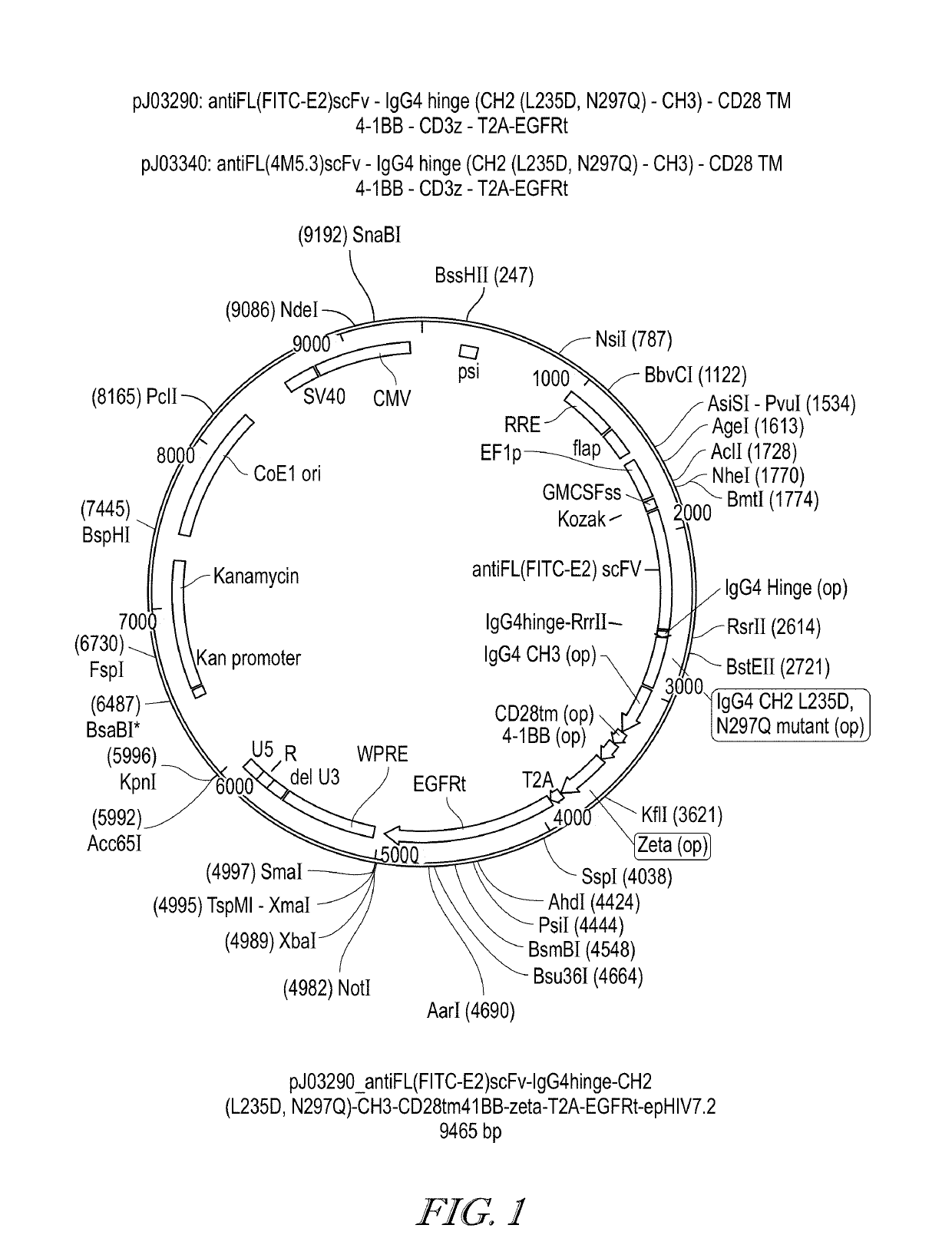Methods of use for car t cells
a car t cell and cell technology, applied in the field of car t cell use, can solve the problems of limited success in eliminating disease (e.g., cancer) in clinical trials, inability to prolong activation and expand the car t cell population in vivo, and inability to reduce or prevent body weight loss due to crs
- Summary
- Abstract
- Description
- Claims
- Application Information
AI Technical Summary
Benefits of technology
Problems solved by technology
Method used
Image
Examples
example 1
EC17 Dose De-Escalation can Reduce Therapy Related Toxicity
[0573]The effect of EC17 dose de-escalation was investigated on the anti-tumor activity and the toxicity (body weight changes) of CAR-T therapy. Two different anti-fluorescein scFv were used for the CAR constructions (FIG. 1). The first construct of CAR contains the following domains: antiFL(FITC-E2)scFv-IgG4 hinge (CH2 (L235D, N297Q)-CH3)-CD28 TM-4-1BB-CD3z-T2A-EGFRt. The second construct of CAR contains the following domains: antiFL(FITC-4M5.3)scFv-IgG4 hinge (CH2 (L235D, N297Q)-CH3)-CD28 TM-4-1BB-CD3z-T2A-EGFRt. The nucleic acid sequence and amino acid sequence of the CAR of each construct are shown as SEQ ID NOS:1 to 4. Human T cells were isolated, activated and transduced with a lentiviral vector carrying the appropriate CAR gene. CD4+ T cells with the CAR-modification and CD8+ T cells with the CAR-modification were isolated and cultured separately in vitro for about 7 days. CD4+ CAR-T cells and CD8+ CAR-T cells were mi...
example 2
Characterization of CAR T Cell Differentiation Phenotypes Prior to Infusion into NSG Mice
[0580]Multi-color flow cytometry was used to determine the phenotypes of CAR T cell products to be infused into tumor-bearing mice. The differentiation status of CD4+ and CD8+ subsets was analyzed using specific combinations of surface markers as shown in FIGS. 7A-C. The unsorted E2 clinical facsimile CAR T cell product was made predominantly of the self-renewing Tscm / Tcm phenotype (FIG. 7D). In FIG. 7D, the highest bar is “Tscm” and the lower bar is “Tcm”. In addition to differences in CD8:CD4 ratios shown in FIG. 8A, the current E2 clinical facsimile CAR T cells were different from the previously sorted E2 / 4M5.3 CAR-T cells and early GFP+4M5.3 CAR T in vivo study preparations (summarized as pie charts in FIG. 8B). In FIG. 8A, in the 10 groups from left to right, the bars represent the following—1 (high bar Tscm, lower bar Tcm), 2—(high bar Tscm, lower bar Tcm), 3—(high bar Teff, lower bar Tem)...
example 3
E2 Anti-FITC Antibody Doesn't Bind with any Human Normal Tissues
[0583]An E2 anti-FITC IgG antibody with the same variable fragment sequences as those in E2 anti-FITC CAR construct was used to test if E2 antibody has any binding with human normal tissues. A recombinant human E2 anti-FITC IgG1 Lambda 1 was expressed in HEK293 cells and purified by using a protein A affinity column. The purity of the antibody was over 98% by using SEC-HPLC analysis. The antibody was labeled with digoxigenin (DIG) using Mix-N-Stain DIG antibody labeling kit (Biotium). The binding affinity of DIG-labeled E2 antibody for FITC-immobilized beads was measured by FACS. Various concentrations of DIG-E2 IgG were incubated with FITC-immobilized beads for 30 min at room temperature. After washing, a monoclonal anti-DIG Ab was added and incubated with beads for 30 min. An eF660 conjugated anti-mouse secondary antibody was added and incubated with the washed beads. The washed beads were analyzed for the eF660 signa...
PUM
| Property | Measurement | Unit |
|---|---|---|
| volume | aaaaa | aaaaa |
| body weight loss | aaaaa | aaaaa |
| body weight | aaaaa | aaaaa |
Abstract
Description
Claims
Application Information
 Login to View More
Login to View More - Generate Ideas
- Intellectual Property
- Life Sciences
- Materials
- Tech Scout
- Unparalleled Data Quality
- Higher Quality Content
- 60% Fewer Hallucinations
Browse by: Latest US Patents, China's latest patents, Technical Efficacy Thesaurus, Application Domain, Technology Topic, Popular Technical Reports.
© 2025 PatSnap. All rights reserved.Legal|Privacy policy|Modern Slavery Act Transparency Statement|Sitemap|About US| Contact US: help@patsnap.com



